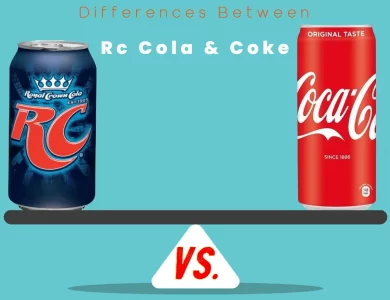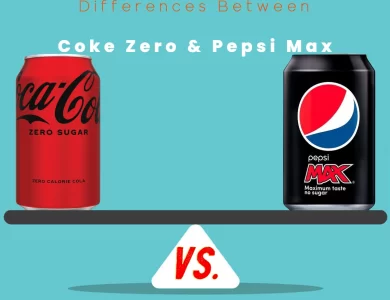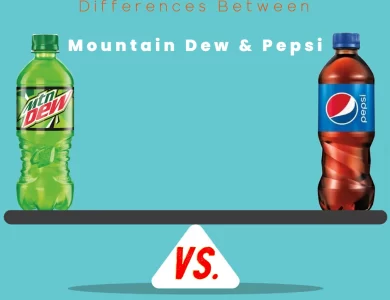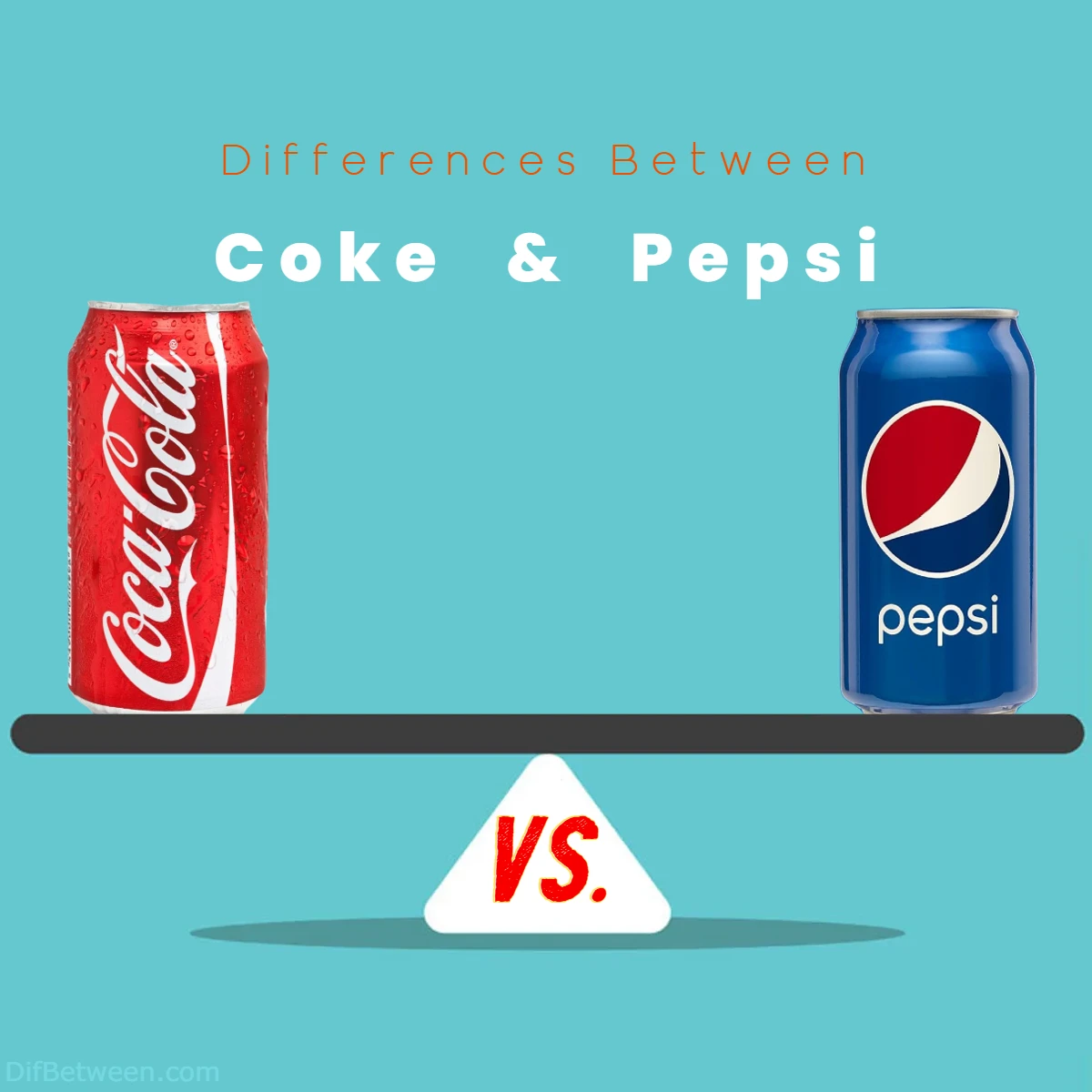
The main differences between Coke and Pepsi lie in their distinct flavor profiles and branding strategies. Coca-Cola offers a smoother, mellow sweetness with subtle citrus undertones, creating a timeless taste cherished by many. On the other hand, Pepsi boasts a tangier flavor, pronounced with a zesty twist that appeals to those seeking a bolder taste experience. Moreover, their branding strategies diverge; Coca-Cola emphasizes unity and shared moments, while Pepsi aligns with youthful energy and pop culture collaborations. These differences in taste and branding cater to varied preferences and values, making the choice between Coke and Pepsi a matter of personal taste and cultural resonance.
| Aspect | Coca-Cola | Pepsi |
|---|---|---|
| Origins | Invented by John S. Pemberton in 1886 | Created by Caleb Bradham in the 1890s |
| Formula | Carbonated water, HFCS (or sugar), caramel color, phosphoric acid, natural flavors, caffeine | Carbonated water, HFCS (or sugar), caramel color, phosphoric acid, citric acid, natural flavors, caffeine |
| Flavor Profile | Smoother, mellow sweetness with citrus undertones | Tangier, more pronounced citrus flavor |
| Packaging | Iconic glass bottle, consistent red-and-white branding | Evolving designs, circular logo, blue color scheme |
| Marketing Approach | Focused on unity and shared moments | Embraces youthful energy, pop culture partnerships |
| Cultural Impact | Associated with traditions and holidays | Linked to dynamic and trendsetting image |
| Global Reach | Distributed in more than 200 countries | Recognized worldwide, strong global presence |
| Sweetener Variations | Introduced variations with cane sugar in select markets | Introduced variations with real sugar in select markets |
| Environmental Efforts | Committed to making packaging 100% recyclable by 2025 | Aims to reduce use of virgin plastic by 35% by 2025 |
| Nutritional Content | Typically contains calories, carbohydrates, caffeine, phosphoric acid | Similar nutritional content, both high in sugar |
| Packaging Diversity | Consistent packaging with iconic glass bottle and other options | Evolving packaging designs, including cans and bottles |
| Cultural Partnerships | Focused on unity and shared moments, major event partnerships | Tied to pop culture, collaborations with celebrities |
| Taste Preference | Mellow sweetness and balanced flavors | Tangy and invigorating taste |
| Nostalgia | Evoke a sense of heritage and familiarity | Reflect changing trends and modern aesthetics |
| Regional Influence | Recognized globally, varies by region | Recognized globally, varies by region |
In the realm of carbonated delights, it’s not just about taste – it’s about nostalgia, branding magic, cultural touchpoints, and so much more. From the distinctive flavors that tickle your senses to the captivating stories behind their origins, each sip of Coke and Pepsi is a journey in itself. So, if you’re as curious as we are to explore what makes these two beverages unique, join us on this delightful adventure as we dive into the very essence of what makes Coke and Pepsi much more than just ordinary drinks.
Differences Between Coke and Pepsi
1. The Battle of Origins
Coca-Cola: A Timeless Classic
Coca-Cola, often referred to simply as “Coke,” has a history as rich and effervescent as its flavor. The beverage traces its origins back to the late 19th century when John S. Pemberton, a pharmacist from Atlanta, Georgia, concocted a syrupy elixir. This elixir, initially formulated as a remedy, was later mixed with carbonated water, giving birth to the beloved beverage we know today.
Coke’s iconic taste hinges on its unique formula that includes a blend of carbonated water, high-fructose corn syrup (or sugar in some regions), caramel color, phosphoric acid, natural flavors, and caffeine. This secret recipe has remained closely guarded for over a century, adding to the allure of the brand.
The brand’s red-and-white label, with its scripted typography, has become synonymous with refreshment, nostalgia, and a timeless American tradition. Coca-Cola’s consistent branding and unmistakable taste have helped it secure a permanent spot in the hearts of soda enthusiasts worldwide.
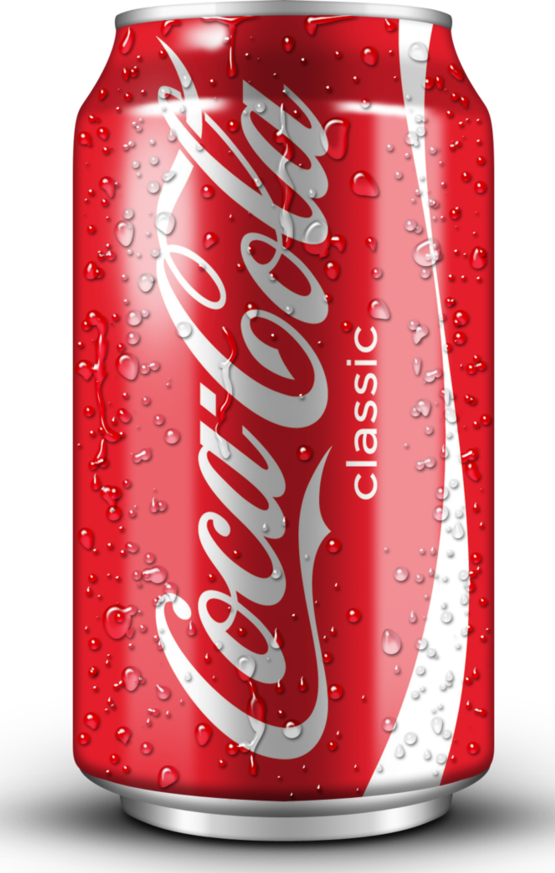
Pepsi: The Challenger with a Twist
Pepsi, on the other hand, entered the beverage scene as a direct challenger to Coca-Cola’s dominance. Created by Caleb Bradham, a pharmacist from North Carolina, in the late 1890s, Pepsi aimed to offer a unique alternative to Coke’s established market presence.
Pepsi’s formula boasts a distinct blend of carbonated water, high-fructose corn syrup (or sugar), caramel color, phosphoric acid, citric acid, natural flavors, and caffeine. One of the notable differences lies in the use of citric acid, which lends Pepsi a slightly tangier taste compared to Coke’s smoother profile.
The Pepsi brand has undergone several logo and packaging redesigns over the years, often reflecting the evolving cultural and design trends. This adaptability has allowed Pepsi to connect with younger generations while maintaining its refreshing and invigorating image.
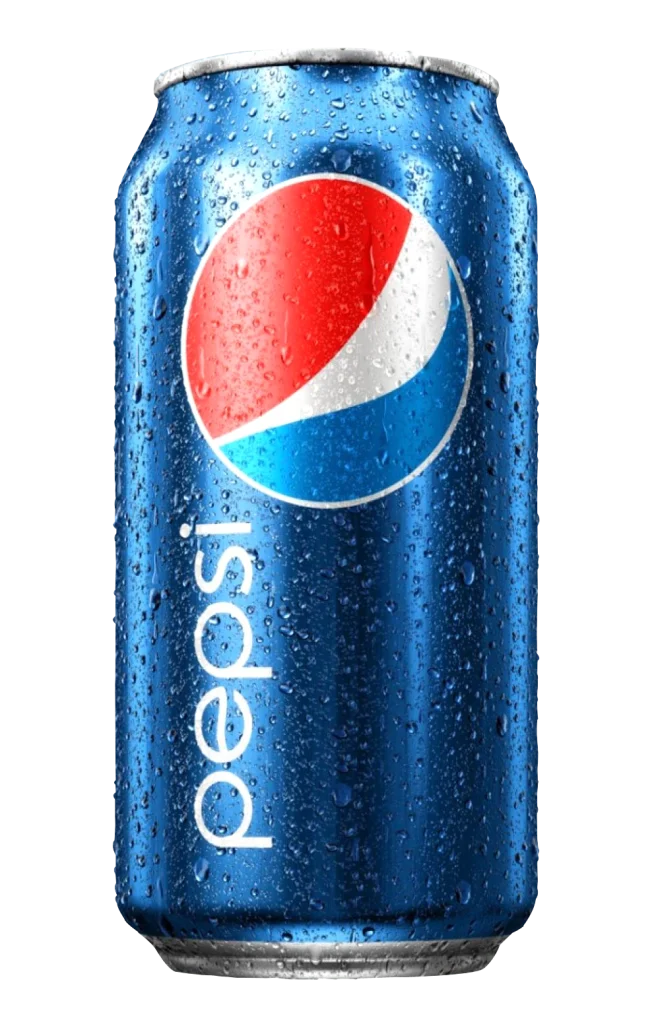
2. Flavor Showdown
Coke: A Symphony of Sweetness
Coca-Cola is renowned for its harmonious blend of sweetness and acidity. The iconic cola taste is often described as having a smoother, mellow sweetness with a touch of citrus undertones. The balance between the sweetness of the high-fructose corn syrup, the bite of the carbonation, and the subtle notes of caramel creates a symphony of flavors that many find comforting and familiar.
Coke’s flavor versatility has also led to the creation of various spin-offs and limited-edition versions, from Cherry Coke to Vanilla Coke, appealing to those seeking a twist on the classic taste.
Pepsi: A Tangy Twist
Pepsi’s flavor profile takes a slightly different route. The inclusion of citric acid lends Pepsi a tangier and more pronounced citrus flavor compared to Coke. This tanginess, combined with the cola’s characteristic sweetness and effervescence, creates a zesty and invigorating experience for the taste buds.
Similar to Coke, Pepsi has also ventured into flavored variations like Pepsi Wild Cherry and Pepsi Vanilla, offering consumers an array of choices that cater to diverse preferences.
3. Marketing Strategies
Coke: The King of Heartfelt Advertising
Coca-Cola has masterfully used its marketing campaigns to tap into emotions and create a sense of togetherness. From the iconic “Hilltop” commercial featuring the harmonious jingle “I’d Like to Buy the World a Coke” to heartwarming holiday ads, Coke’s advertising focuses on creating moments of connection and joy. The brand’s presence in pop culture, especially during the holiday season with its famous Christmas truck commercials, has solidified its role as a symbol of unity and celebration.
Coca-Cola’s consistent branding, emotional resonance, and focus on sharing have helped it become more than just a beverage – it’s a part of cultural experiences and cherished memories.
Pepsi: The Bold and Youthful
Pepsi, in contrast, often positions itself as the choice of a new generation. The brand’s marketing campaigns have traditionally embraced youthful energy, pop culture, and celebrity endorsements. The iconic Pepsi Challenge of the 1970s and 1980s, which dared consumers to blind taste-test Coke and Pepsi, was a bold move that highlighted Pepsi’s confidence in its flavor.
Pepsi’s collaborations with artists, musicians, and athletes have contributed to its image as a dynamic and trendsetting brand. The brand’s campaigns often reflect a spirit of adventure and rebellion, resonating with younger consumers seeking excitement and change.
4. Global Reach and Popularity
Coke: The Global Phenomenon
Coca-Cola’s red label and curvaceous bottle are recognized worldwide. The brand’s distribution network spans across more than 200 countries, making it one of the most universally recognized and consumed beverages on the planet. Coke’s longstanding legacy, along with strategic partnerships and consistent quality, have helped it become a symbol of American culture while transcending cultural boundaries.
Pepsi: A Global Contender
Pepsi’s blue label and distinctive circular logo have also achieved significant global recognition. While it may not have the same historical depth as Coca-Cola, Pepsi has strategically positioned itself as a strong competitor in the international beverage market. Through innovative marketing campaigns, strategic partnerships, and localized flavors, Pepsi has managed to carve out a substantial presence in the global arena.
5. The Sweetener Saga
Coke: High-Fructose Corn Syrup or Sugar?
One of the notable differences between Coke and Pepsi lies in their choice of sweeteners. In the United States, Coca-Cola traditionally used high-fructose corn syrup as its sweetener. However, recognizing growing consumer preference for natural ingredients, Coca-Cola released variations like “Coca-Cola with Cane Sugar,” made with real sugar, in select markets. These variations offer a slightly different taste experience for those who prefer the classic cola flavor with a different source of sweetness.
Pepsi: Straddling Sweetener Options
Pepsi, too, has experimented with sweeteners. In the United States, the brand typically uses high-fructose corn syrup. Yet, Pepsi has also embraced the trend towards natural ingredients, introducing variations like “Pepsi Made with Real Sugar.” This approach allows Pepsi to cater to different segments of consumers who have varying preferences regarding sweeteners.
6. Package Design and Visual Identity
Coke: The Classic Elegance
Coca-Cola’s packaging has maintained a sense of classic elegance throughout its history. The iconic glass bottle, with its curvaceous shape, has become synonymous with the brand. This distinctive bottle design not only aids in recognition but also adds a touch of nostalgia to the drinking experience. Over the years, Coca-Cola has expanded its packaging options to include cans, plastic bottles, and more, while still keeping the red-and-white color scheme and scripted logo consistent.
Coke’s commitment to its visual identity extends beyond its packaging. The brand’s advertisements, merchandise, and even its vending machines often feature the same red hue and familiar typography, creating a cohesive and instantly recognizable image.
Pepsi: The Evolution of Modernity
Pepsi’s packaging has seen more frequent design changes, often reflecting contemporary design trends. The brand’s logo and packaging have evolved over the years to cater to changing consumer preferences and design aesthetics. While the circular logo and blue color scheme have remained relatively consistent, Pepsi’s packaging has embraced various shapes, sizes, and materials, including the classic can, plastic bottles, and even sleek aluminum bottles.
Pepsi’s willingness to experiment with packaging design has allowed it to appeal to different generations and stay attuned to current design sensibilities.
7. Cultural Impact and Partnerships
Coke: A Symbol of Unity
Coca-Cola’s marketing campaigns have often focused on unity and togetherness, transcending cultural boundaries. The brand’s “Share a Coke” campaign, which replaced its logo with popular names, encouraged people to connect and share moments with each other. Additionally, the Coca-Cola polar bears and Santa Claus have become iconic figures in holiday celebrations, contributing to the brand’s cultural impact and association with joyous occasions.
Coke’s partnerships with major events like the Olympics and FIFA World Cup further underline its global presence and commitment to fostering unity through shared experiences.
Pepsi: Pop Culture Partnerships
Pepsi has positioned itself as a brand closely tied to pop culture. Through partnerships with music icons, athletes, and celebrities, Pepsi has consistently tapped into the latest trends and captured the spirit of the times. The brand’s memorable advertisements, featuring stars like Michael Jackson, Britney Spears, and Beyoncé, have contributed to its image as a dynamic and youthful choice.
Pepsi’s ability to align itself with influential cultural figures and moments has allowed it to stay relevant and resonate with a wide range of consumers.
8. Nutritional Differences
Coke and Pepsi: Nutritional Similarities
In terms of nutritional content, Coke and Pepsi are quite similar. Both beverages typically contain calories, carbohydrates (mainly from sugars), caffeine, and some levels of phosphoric acid. Their calorie and carbohydrate content primarily comes from high-fructose corn syrup (or sugar, depending on the version) used as a sweetener.
Both brands have introduced diet versions with artificial sweeteners like aspartame or sucralose to cater to consumers looking for reduced-calorie options.
It’s important to note that neither of these beverages is considered a healthy choice due to their high sugar content and lack of essential nutrients. Moderation is key when consuming these sodas.
9. Environmental Initiatives
Coke and Pepsi: Sustainability Efforts
In recent years, both Coke and Pepsi have taken steps to address environmental concerns. Both companies have made commitments to reduce their carbon footprint, promote recycling, and use sustainable packaging materials. Initiatives include using plant-based plastics, increasing the use of recycled materials, and investing in eco-friendly technologies.
Coca-Cola, for instance, has set a goal to make its packaging 100% recyclable by 2025, while PepsiCo aims to reduce its use of virgin plastic by 35% by the same year.
These efforts reflect a growing awareness within the beverage industry about the importance of sustainability and responsible environmental practices.
10. Regional Preferences
Coke and Pepsi: Regional Variances
While both Coke and Pepsi have a global reach, consumer preferences can vary significantly from region to region. Some regions may have a stronger preference for one brand over the other based on historical factors, cultural associations, and advertising campaigns.
For instance, in some countries, one of the brands may have a stronger presence due to early market entry or successful localization efforts. These regional preferences often stem from factors beyond taste, including marketing strategies, historical context, and cultural perceptions.
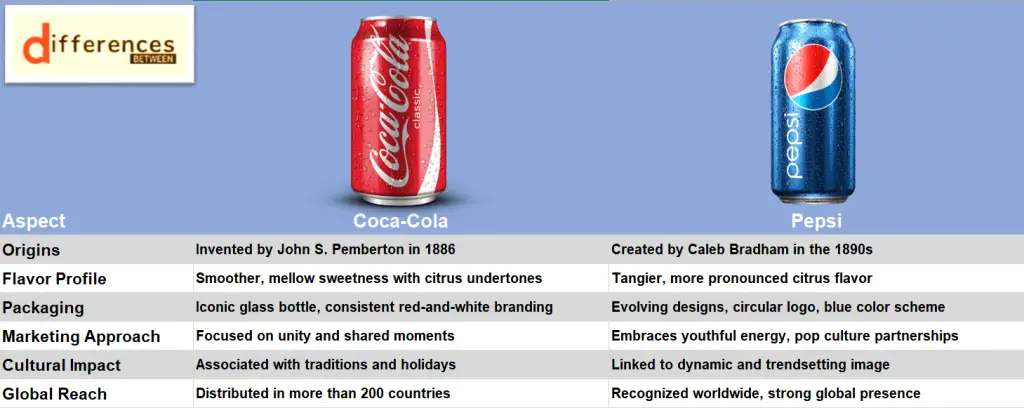
Coke or Pepsi: Which One is Right for You?
The eternal debate between Coke and Pepsi continues to captivate soda enthusiasts and casual consumers alike. With their distinct flavors, branding strategies, and cultural impacts, both beverages have carved their places in the hearts of millions. So, when faced with the decision of which one to choose, how can you determine which is right for you? Let’s break down some factors that might influence your choice.
Taste Preferences
Coca-Cola’s Classic Elegance
If you’re drawn to a smoother and mellow sweetness with a touch of citrus undertones, Coca-Cola might be your ideal choice. The harmonious blend of flavors in Coke is often described as iconic and comforting. Its balanced sweetness and subtle caramel notes create a timeless taste that’s easy to enjoy, making it a go-to option for many.
Pepsi’s Zesty Twist
On the other hand, if you’re looking for a tangy and invigorating experience, Pepsi might be more up your alley. Pepsi’s slightly pronounced citrus flavor, along with its cola sweetness, delivers a zesty and refreshing taste that appeals to those who enjoy a bolder profile.
Consider your taste preferences – whether you lean towards smooth and mellow or crave a tangy kick – when deciding between the two.
Nostalgia and Brand Loyalty
Coca-Cola: Timeless Traditions
For those who value tradition and a sense of nostalgia, Coca-Cola’s timeless branding might resonate deeply. The brand’s classic red-and-white label and scripted typography evoke a sense of familiarity and heritage. If you have fond memories associated with Coke, its iconic image might be difficult to resist.
Pepsi: Dynamic and Trendsetting
If you’re someone who thrives on novelty and embracing new experiences, Pepsi’s ever-evolving image and youthful approach could be more appealing. Pepsi’s history of collaborating with pop culture icons and embracing contemporary design trends might speak to your desire for something fresh and exciting.
Consider your emotional connection to the brand and the memories it conjures up – whether that’s the feeling of sharing a Coca-Cola with friends or the excitement of trying a new Pepsi flavor.
Cultural Impact
Coca-Cola: Unity and Connection
If you value the idea of bringing people together and celebrating shared moments, Coca-Cola’s marketing campaigns focused on unity might resonate with you. The brand’s commitment to creating moments of togetherness, especially during holidays, could align with your own values.
Pepsi: Youthful Energy
On the other hand, if you identify with a sense of youthful energy and a desire to be part of current trends, Pepsi’s dynamic pop culture partnerships might draw you in. Pepsi’s campaigns often align with a spirit of adventure and rebellion, which could resonate with your own outlook.
Consider how the brands’ cultural impacts and messages align with your personal values and aspirations.
Packaging and Presentation
Coca-Cola: Classic Elegance
Coca-Cola’s iconic glass bottle and consistent red-and-white branding might appeal to your sense of classic elegance. The bottle’s shape and design are instantly recognizable and can enhance the drinking experience.
Pepsi: Modern Dynamism
If you’re more inclined towards modern aesthetics and a willingness to embrace change, Pepsi’s evolving packaging designs might catch your eye. The brand’s ability to adapt its visual identity could align with your appreciation for contemporary design.
Consider how the packaging aligns with your personal style and preferences – whether you’re drawn to classic or modern aesthetics.
Regional and Cultural Influences
Coke and Pepsi: Local Tastes
Keep in mind that your regional location and cultural influences could impact your preference. In some regions, one brand might have a stronger presence due to historical factors, local marketing strategies, or consumer preferences. Pay attention to what’s popular in your area and whether you identify with any regional loyalties.
In the end, the choice between Coke and Pepsi is a matter of personal preference. Both brands have their own unique qualities, and neither is objectively better than the other. Whether you’re drawn to the classic elegance of Coca-Cola or the zesty twist of Pepsi, both beverages have left an indelible mark on the world of carbonated refreshments. So go ahead, raise a glass to your favorite and enjoy the effervescent delight that these iconic brands bring to your life.
FAQs
Coke and Pepsi differ primarily in flavor and branding. Coca-Cola offers a smoother, mellow sweetness with subtle citrus undertones, while Pepsi has a tangier, zesty flavor. Branding-wise, Coca-Cola focuses on unity and shared moments, while Pepsi aligns with youthful energy and pop culture collaborations.
Yes, there are ingredient variations. While both contain carbonated water, high-fructose corn syrup (or sugar), caramel color, and phosphoric acid, Pepsi also includes citric acid in its formula for a tangier taste.
Both have a strong global presence, but Coca-Cola’s distribution network spans over 200 countries, making it universally recognized. Pepsi also has significant international reach through its dynamic branding and partnerships.
Nutritionally, they’re quite similar, both containing calories, carbohydrates, caffeine, and some phosphoric acid. However, neither is considered healthy due to their high sugar content and lack of nutrients.
Coca-Cola emphasizes unity and heartwarming moments in its marketing, while Pepsi aligns with youthful energy and collaborations with pop culture icons, musicians, and celebrities.
Yes, regional preferences can influence the choice due to factors like historical market presence and cultural associations.
Coca-Cola maintains a classic red-and-white visual identity, often associated with tradition. Pepsi’s packaging evolves to stay in tune with contemporary design trends, appealing to those seeking modernity.
Both brands have committed to sustainability. Coca-Cola aims to make its packaging 100% recyclable, while PepsiCo strives to reduce virgin plastic use by 35%.
Coca-Cola’s smoother, balanced sweetness appeals to those who prefer a mellow flavor, while Pepsi’s tangier taste caters to those who enjoy a zesty twist.
Absolutely, nostalgia plays a role. Coca-Cola’s classic branding evokes tradition and heritage, while Pepsi’s dynamic image resonates with those seeking modern experiences.
Read More:
